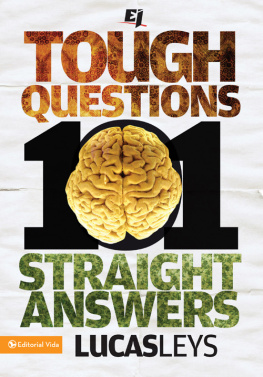
The Art of Asking
Ask Better Questions, Get Better Answers
Terry J. Fadem
Vice President, Publisher: Tim Moore
Associate Publisher and Director of Marketing: Amy Neidlinger
Acquisitions Editor: Jennifer Simon
Editorial Assistants: Myesha Graham and Heather Luciano
Development Editor: Russ Hall
Operations Manager: Gina Kanouse
Digital Marketing Manager: Julie Phifer
Publicity Manager: Laura Czaja
Assistant Marketing Manager: Megan Colvin
Managing Editor: Kristy Hart
Project Editor: Betsy Harris
Copy Editor: Keith Cline
Proofreader: San Dee Phillips
Interior Designer: Gloria Schurick
Cover Designer: Tobias Design
Compositor: Nonie Ratcliff
Manufacturing Buyer: Dan Uhrig
2009 by Pearson Education, Inc.
Publishing as FT Press
Upper Saddle River, New Jersey 07458
FT Press offers excellent discounts on this book when ordered in quantity for bulk purchases or special sales. For more information, please contact U.S. Corporate and Government Sales, 1-800-382-3419, .
Company and product names mentioned herein are the trademarks or registered trademarks of their respective owners.
All rights reserved. No part of this book may be reproduced, in any form or by any means, without permission in writing from the publisher.
Printed in the United States of America
First Printing December 2008
ISBN-10: 0-13-714424-5
ISBN-13: 978-0-13-714424-2
Pearson Education LTD.
Pearson Education Australia PTY, Limited.
Pearson Education Singapore, Pte. Ltd.
Pearson Education North Asia, Ltd.
Pearson Education Canada, Ltd.
Pearson Educatin de Mexico, S.A. de C.V.
Pearson EducationJapan
Pearson Education Malaysia, Pte. Ltd.
Library of Congress Cataloging-in-Publication Data
Fadem, T. J. (Terry Jay), 1948
The art of asking : ask better questions, get better answers T.J Fadem.
> p. cm.
Includes bibliographical references.
ISBN 0-13-714424-5 (pbk. : alk. paper) 1. Communication in management. 2. Management.
3. Executive ability. 4. Organizational behavior. I. Title.
HD30.3.F33 2008
658.45dc22
2008007868
Contents
Dedication
But dost thou know what will be tomorrow?
The Grand Inquisitor, in The Grand Inquisitor, by Fyodor Dostoevsky
Praise for The Art of Asking
Terrys insights on this essential subject are brilliant and practical at the same time. His stories are wonderful and drive his points home with both humor and stark clarity. He provides questions and approaches that one can implement immediately. Required reading for every leader who wishes to see his or her organization flourish and career progress.
Garry A. Neil, MD, Corporate Vice President, Johnson & Johnson
Terry has done it. Asking, listening, understanding the real meaning of the answers, and taking actions based on facts are really the essence of managing a process, an organization, or a corporation. This book has helped me in connecting the dots in my understanding (and lack thereof) of why things really did not work the way I expected them to work.
The Art of Asking is really a practical guide for everyday management. This book should be a part of any core curriculum for management training, irrespective of the managers areas of focus.
Pradip Banerjee, PhD, Chairman and Chief Executive Officer, Xybion; retired partner, Accenture
This is a unique and valuable guide to asking the right question at the right time. It is also about using insightful questions to exercise leadership. As Peter Drucker once observed, The leader of the past knew how to tell. The leader of the future will know how to ask.
George Day, Geoffrey T. Bosi Professor of Marketing, Wharton Business School
The framework and techniques provide outstanding ideas for executives to both gain better information and develop the analytical skills of their teams through Socratic learning.
Terry Hisey, Vice Chairman and U.S. Life Sciences Leader, Deloitte
An easy read! Terry shares his past corporate experiences and explains in simple terms how to improve your chances of success through better questioning. Right on the money!
Mark Hopkins, entrepreneur and small business owner
Disclaimer
The events described in this book are true to the best of the authors ability to recall them. Names and details that might identify people or companies have been changed, wherever possible, to protect the identity of the innocent as well as the guilty.
Acknowledgments
I want to acknowledge the contributions of my familySusan, Lynne, and Charles Fademfor their patience in listening to my rendition of the stories that appear on the following pages, over and over again. And to Q and Ginger, who both barked furiously at me to walk them whenever I was deep in thought about some important management questions, as if to remind me that good management is often something that just happens.
About the Author
T.J. (Terry) Fadem is a veteran manager with 25 years of experience ranging from supervising steel workers (J&L Steel) to managing in a major corporation (DuPont) to working with start-up companies. His business venture teams have been profiled in books and periodicals, and he has also been a frequent speaker and consultant on strategic management issues. Fadem is currently the managing director, Corporate Alliances at the School of Medicine at the University of Pennsylvania where he is also a member of the Core Team of the Mack Center for Technological Innovation at the Wharton School. In addition, Fadem is president of the Biomedical Research and Education Foundation.
Preface: Corporate Inquisitions
The Not-So-Grand Inquisitor
He sat behind a desk holding a pitchfork, as all upper-level managers do when they are bedeviling their employees. Well, at least thats how many people picture the boss. This guy was actually holding one that resembled an implement of the devila long black handle with a red trident at the end. An appropriate accompaniment for a kid in a Halloween costume, it was out of place with the corporate blue suit of the middle-aged business director. But, as you will see in a moment, this was a manager who was out of step with his business.
Managing business development efforts for a major electronics company with worldwide supply chains is a daunting job for anyone. He had responsibility for overseeing a major growth initiative for the companyone that would likely determine the future of the division. His infrequent visits to the facility that housed the main business unit were as welcome as the arrival of bird flu.
The project he had come to review was beset with problems. The marketing organization criticized research, believing that the product design would not meet customer expectations. Every redesign that satisfied the demands of marketing added costs to the product that threatened to price it out of the market it was targeted to reach, thus making the salespeople very unhappy. And they all argued with manufacturing because no matter what design was settled on, no one in the plant had any confidence the product could be manufactured reliably. The project was woefully behind schedule and so far over budget that the likelihood of recovering development costs had become a major concern for management.
The desk that he was using, as a physical barrier between himself and the team as much as anything else, rested on a concrete platform, about a foot high, in an old factory warehouse. He actually needed the desk because this particular group of employees was known to hurl chairs when they disagreed with each other. Who knows what they might heave at this guy? Although the original purpose of the elevated floor was to keep gunpowder dry, it now functioned as a stage on which the manager attempted to transform himself into an inquisitor. He had come to visit a business team that was producing a seemingly unending stream of problems rather than products.
Next page











